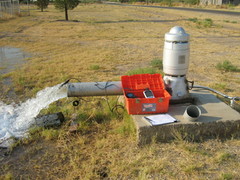Groundwater Sampling Program
Although groundwater used for drinking purposes typically does not contain dissolved constituents in excess of their Maximum Contaminant Levels, which could pose health risks, it is important to monitor groundwater quality periodically over time to detect trends in the concentrations of these constituents. Certain constituents pose greater risks than others as listed in the Priority Contaminant Ranking in Groundwater in Texas.
Priority Contaminant Ranking in Groundwater
Rank 1 - Severe Health Threat
- Bacteria
- Bacteria can cause gastro-enteric illness and may indicate fecal contamination. Although it is often tested for in private wells when property with a well is sold, the analysis may not be performed at a certified lab
- Nitrate, NO3-
- The presence of NO3-/NO2- can indicate fecal contamination. Nitrate and nitrite can cause blue-baby syndrome.
- Nitrite, NO2-
- Nitrate and nitrite are immediate risks to young children and pregnant mothers.
Rank 2 - Moderate Health Threat
- Arsenic
- Arsenic has a health-based standard based on long term risk and occurs relatively frequently in Texas public water systems (most frequently of the constituents with primary drinking water standards).
- Fluoride
- Fluoride has a health-based standard based on long term risk and occurs relatively frequently in Texas public water supply systems (second most frequently detected in excess of primary standards).
- Gross alpha, radium 226+228
- Radionuclides (including emissions from uranium) naturally occur in several Texas aquifers. Analysis methods, identifying all three, are more expensive than for other constituents.
- Uranium
- Uranium may also cause metal toxicity in excess amounts, not related to emission of radionuclides. Analysis as a metal is separate from analysis for radionuclide emission.
Rank 3 - Minimal Health Threat
- VOCs
- Texas has naturally occurring and anthropogenic Volatile Organic Compounds (VOCs). Occurrence infrequently indicates explosion risk, with ingestion of lesser concern.
- Pesticides
- Pesticides are rarely detected and even more rarely detected at levels above the health-based standard based on long-term (2 liters/70 years) health risks.
- Sulfate, SO4-
- Sulfate can cause "traveler's diarrhea," but does not cause any health issues to people acclimated to the water--therefore a low concern for homeowner.
- Manganese
- Manganese causes no identified health concerns; instead, the element causes colored water, and is therefore of less concern for the homeowner.
- Perchlorate
- Although Texas has naturally occurring and anthropogenic perchlorate, occurrence is likely not high. EPA has still not set a standard based on perchlorate (ClO4-)'s long-term risks.
- Radon
- Radon is a much greater concern in air than in water, and radon detectors for air (similar to smoke detectors) are a much more efficient way of determining if a private residence is at risk from radon.
The TWDB tests for most of the dissolved inorganic constituents listed above including nutrients (nitrate/nitrite) and radionuclides. Bacteria in groundwater, while of the greatest concern for well owners using their well water for drinking, may be tested for inexpensively at many county health departments and numerous private analytical labs. Texas Agrilife Extension Service recommends that well disinfection be performed by professionals.
Link to Additional Private Water Well Sampling Resources
Primarily, the TWDB groundwater quality monitoring program consists of collecting samples directly from the aquifer, before treatment, in accordance with procedures established in the TWDB's Field Manual for Groundwater Sampling. Protocols outlined in this manual have been followed consistently since 1988 to ensure network continuity. Results from analyses sampled by other entities in cooperative agreements with the TWDB in which the TWDB's sampling protocols are followed are also entered in the TWDB Groundwater Database and coded appropriately, as are water quality data from certain other programs from a variety of state, local, and federal agencies that collect in Texas. The TWDB samples a representative number of wells from each of the state's 9 major and 21 minor aquifers, throughout their extent, once every four years.
No other state agency is equipped or mandated to monitor statewide ambient groundwater quality or obligated to sample using the TWDB's methods, although numerous other agencies collect data for their own purposes. The TWDB has recently participated in a joint research project with the Bureau of Economic Geology to provide more guidance to well owners in the state who depend on their well water for drinking purposes. As part of this Private Well Initiative project, funded by the Centers for Disease Control from 2011 through 2013, we conducted a survey of water quality data-collection programs administered by other agencies in Texas. Sampling programs are hardly a one-size-fits-all proposition and are geared toward specific customers and concerns. Whether these programs are driven by regulatory, scientific research, or determination of basic health issues, each contributes to the overall and specific knowledge necessary to characterize groundwater and its relative drinkability and usability.
